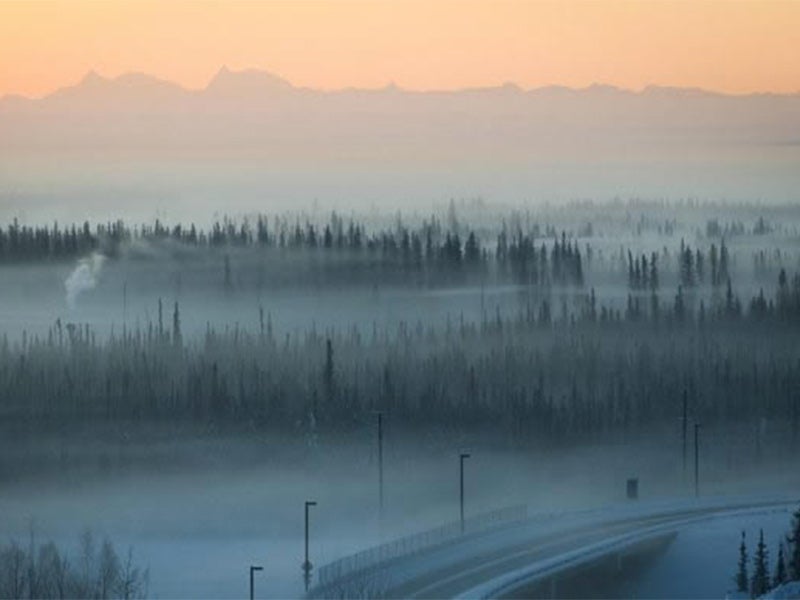EPA Convinced to Address Fairbanks’s Dirty Air
After Fairbanks residents filed a lawsuit, EPA finally agreed to address the worst spikes of fine particulate matter pollution in the country
Contacts
Kenta Tsuda, Earthjustice, (907) 500-7129
,
Patrice Lee, Citizens for Clean Air, (907) 799-9580
,
Pamela Miller, Alaska Community Action on Toxics, (907) 222-7714 (office), (907) 242-9991 (cell)
Today the U.S. Environmental Protection Agency (EPA) published notice that Fairbanks has been reclassified as “serious” non-attainment area. This long-overdue action triggers requirements for the state to adopt the strictest measures available to address Fairbanks’s ongoing pollution problems and bring the area into compliance with national air quality standards. The determination comes under pressure from a pending lawsuit by Fairbanks residents, represented by Earthjustice, seeking to enforce EPA duties after the agency missed three deadlines in three years to ensure that the State of Alaska addresses Fairbanks’s air pollution problem.
The Fairbanks North Star Borough has the worst spikes in fine particulate matter air pollution in the nation.
The Fairbanks North Star Borough has the worst spikes in fine particulate matter air pollution in the nation—with levels spiking far in excess of the next most-polluted area and more than three and a half times the recommended limit for healthy air. The air pollution problems have worsened since 2009, when state and municipal officials were first advised that soot and smoke levels in Fairbanks were unhealthy and dangerous.
The type of fine particulate matter pollution prevalent in Fairbanks—2.5 micrometers or less in diameter—has been found to cause a wide range of serious health problems, including asthma attacks, chronic respiratory disease, reduction in lung function, hospitalizations and emergency room visits for cardiopulmonary diseases, cancer, and even premature death. Fine particulate matter air pollution is of particular danger to children, reducing lung development, causing asthma, and impairing the immune system. The elderly and those with chronic disease also face heightened risks. Sources of fine particulate matter in Fairbanks include outdoor burning, wood- and coal-burning heating devices, automobiles and other vehicles, and industrial facilities like coal-fired power plants.
The Clean Air Act requires areas like Fairbanks that fail to meet clean air standards to bring themselves into compliance within six years of being deemed non-compliant. Fairbanks missed this deadline, and the law required EPA to designate the Borough as a “serious non-attainment area,” triggering stricter pollution control requirements to finally meet clean air standards. Fairbanks residents brought suit in October when EPA failed to take this action. Today, the agency has at last taken the overdue action.
This is the third time the groups have been forced to sue EPA in the past three years to spur needed action to start cleaning up Fairbanks’s air.
In April 2014, the groups sued EPA for failing to move the state planning process for cleaning Fairbanks’s air forward. This helped prompt the State of Alaska to submit an overdue plan to address air pollution to EPA at the end of January 2015.
In June 2016, the groups sued EPA for its failure to approve or disapprove the State’s plan by the statutory deadline. In January, the Court entered a consent decree requiring the agency to reach a final decision by the end of August 2017.
Citizens for Clean Air, Alaska Community Action on Toxics, and the Sierra Club filed a complaint initiating the lawsuit in the federal district court for the Western District of Washington, where the EPA’s regional office is based. The groups are represented by the Alaska office of the nonprofit environmental law firm Earthjustice.
The following are statements from the groups:
Patrice Lee, Citizens for Clean Air: “Extreme high levels of fine particulate matter continue to threaten the health, safety, and economic viability of our communities. EPA’s determination today is a step in the right direction. But much remains to be done. We must come together to solve this problem by reducing smoke and other forms of air pollution without further delay. Cleaner, affordable energy and heating options will promote healthier living and economic incentives for Interior residents and those who are considering investing in the Fairbanks North Star Borough.”
Pamela Miller, Executive Director, Alaska Community Action on Toxics: “We’re glad that EPA finally took this long overdue action, and that the agency recognizes the serious dangers to public health from the extremely hazardous air pollution in Fairbanks. It’s a shame that we’ve had to resort to legal action to force the agency to do its job. We will remain vigilant to ensure that the Clean Air Act process results in significant measures that protect the health of our community.”
Kenta Tsuda, Attorney, Earthjustice: “The work of Fairbanks residents to secure clean air for their community continues, but we’re pleased that EPA has finally made progress in the process of cleaning up Fairbanks’s air.”

Additional Resources
About Earthjustice
Earthjustice is the premier nonprofit environmental law organization. We wield the power of law and the strength of partnership to protect people's health, to preserve magnificent places and wildlife, to advance clean energy, and to combat climate change. We are here because the earth needs a good lawyer.
